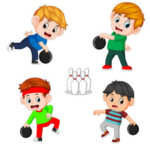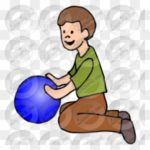
by Neetu | Jun 17, 2020 | Fitness Activity
Posture: Matsya-asana – The Fish Pose
(Pronunciation: maht-see-yah-sa-na)
Description:
The Sanskrit word Matsya means fish, therefore this is the fish posture. Matsya (depicted to the left) is a divine being, found in Hindu mythology, that saved mankind from a universal flood.
Performing Instructions:
- Lie flat on the back in the shava-asana.
- Keeping the buttocks on the floor, inhale and raise the head, shoulders, back, and upper arms off the floor arching the back and raising the chest up. Tilt the head back and place the top of the head flat on the floor.
- Raise the elbows off the floor bring your hands up just below the chest and join them at the palms with the fingers pointing straight up (form the Anjali-mudra or salutation hand gesture). Hold for the duration of the inhale breath or breath gently through the nostrils to remain in the posture longer.
- Return to the shava-asana.
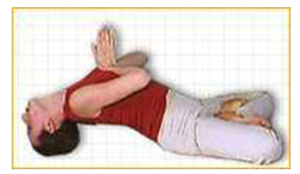
Comments:
The matsya-asana creates a great expansion and stretching of the chest which helps relieve upper respiratory congestion as well as benefits the heart. Additionally, the sinus are drained and opened from the inversion of the head, stretching of the neck and pressure placed on the top of the head. The thyroid and parathyroid glands are stimulated as well.
Duration/Repetitions:
Since this is not a difficult posture, it is recommended that you breathe while holding it for between two and four minutes. If you are uncomfortable breathing, hold the posture for the duration of the inhaled breath. Repeat two or three times.
Variation
There is one major variation in the Matsya-asana and it is a bit more challenging than the one described above (illustrated above). It calls for beginning the posture in Padma-asana or the full lotus seated posture and then lying flat on the back while the legs are still locked. From there on the posture is done the same way as described above.
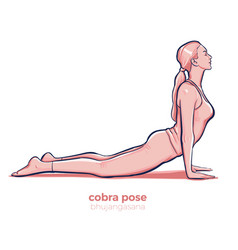
by Neetu | Jun 17, 2020 | Fitness Activity
Posture: Naga-asana – The Cobra Pose
(Pronunciation: na-gah-sa-na)
Description:
The Sanskrit word naga means snake or serpent. The naga-asana is also known as the bhujanga-asana. The Sanskrit word bhujanga, which also means snake, is derived from the root bhuj which means to bend or curve.
“Let the body, from navel to toes, touch the ground, the palms placed upon the ground, and raise gently the upper part of the body (from navel to head) like a snake. This posture increases the gastric fire; it destroys all diseases and by constant practice leads to the awakening of Kundalini.”
Performing Instructions
- Lie on the stomach with the head turned to one side and the arms alongside the body with palms facing upward
- Turn the head and place the chin on the floor. Inhale then exhale slowly through the nostrils and swing the arms around until the hands are placed just below the chin with the palms down and the fingertips of each hand almost touching and the elbows on the floor.
- Inhale slowly through the nostrils, press down on the hands and lift the torso from the waist up off the floor, arching the spine backward and straightening the arms. Keep the hips on the floor.
- Tilt the head as far back as possible and hold the posture for the duration of the inhaled breath.
- Exhale and reverse the process to return to position #1.
Comments:
If you find it uncomfortable holding the breath while the posture is held, breath gently through the nostrils. Some may find that they are able to arch the spine back even more than in the initial arch in step 3. In this case, try “walking” the hands toward the pelvic region and stretching the head further back.
In addition to the obvious benefits to the spine and lower back, the standard variation of the naga-asana strengthens the wrists and stretches the muscles in the chest. By maintaining a constant exertion to create a greater arch in the spine, the stomach and pelvic muscles are strengthened. Greater strength in these areas can be cultivated by performing the variation where the arms remain on the ground. There are claims that displaced spinal discs can be placed back in their original position by practicing the naga-asana.
Duration/Repetitions
Hold the posture for either the duration of a held inhaled breath or from one-half to three minutes. Repeat the naga-asana two to five times.
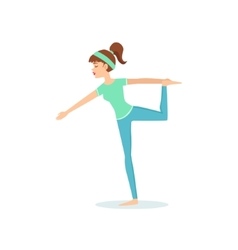
by Neetu | Jun 17, 2020 | Fitness Activity
Posture: Nataraja-asana (The King of the Dance Pose)
(Pronunciation: nah-tah-raj-ah-sa-na)
Description:
The Sanskrit word nata means dancer and raja means king. Nataraja is another name for Shiva, the Lord of the Dance, whose cosmic dance is the creation and destruction of the world.
Performing Instructions:
- Stand with the feet together and the arms by your sides (see the tad-asana).
- Inhale and bend the right leg backward grasping the left foot with your left hand while simultaneously extending the right arm straight out in front.
- Continue raising the right arm upward until it is about 45 degrees from the floor while lifting the left leg as high as possible with the left arm.
- Hold the posture while breathing gently through the nostrils. Keep your gaze fixed slightly above the horizon.
- Remain in the nataraja-asana for about one minute then return slowly to a standing position. Repeat by reversing directions 2-4.
Comments:
Perform the nataraja-asana gracefully as if dancing, yet firmly with focused attention.
This posture helps to strengthen your sense of balance and concentration. The arch formed by the back and stretched leg gently aligns the vertebrae of the spine restoring suppleness and easing strain caused by poor posture or long periods of sitting. It tones the muscles of the hips and legs as well as stimulates the chest muscles.
Duration/Repetitions
Begin by holding the nataraja-asana for about a minute and gradually increase the time as you become more comfortable with this posture. Repeat it three times on each side, alternately from right to left.

by Neetu | Jun 17, 2020 | Fitness Activity
Posture: Dhanura-asana – The Bow Pose
(Pronunciation: dha-noor-ah-sa-na)
Description:
The Sanskrit word dhanur means bow-shaped, curved or bent. The bow referred is a bow as in “bow and arrow.” This asana is so named because the body mimics the shape of a bow with its string stretched back ready to shoot an arrow.
Performing Instructions
- Lie flat on the back in the shava-asana (corpse pose).
- Lie on the stomach with the head turned to one side and the arms alongside the body with palms facing upward.
- Turn the head and place the chin on the floor. Exhale, bend the knees, reach back with the arms and grasp the right ankle with the right hand and the left ankle with the left hand.
- While inhaling, slowly raise the legs by pulling the ankles up and raising the knees off the floor while simultaneously lifting the chest off the floor. Hold the inhale breath. The weight of the body should be resting on the abdomen.
- Tilt the head as far back as possible. Hold the posture as long as you can comfortably hold the inhale breath.
- Slowly exhale bringing the knees to the floor, release the ankles, slowly bring the legs and arms straight down on the floor and turn the head to one side, assuming the prone posture you began with.
Comments:
The most obvious benefit of the dhanur-asana is that it restores flexibility to the spine. Regular practice will relieve lower back pain and release tension and strain in the upper back and neck area. The alternating stretching and releasing of the abdominal muscles increases blood flow to this area and aids all sorts of digestive disorders and discomforts. Strain or fatigue in the legs is also released after a few repetitions. Extended practice will help develop upper-body strength.
Duration/Repetitions:
The dhanur-asana is either held for the duration of the inhaled or between one and three minutes while breathing gently through the nostrils. Repeat it two or three times.
Variations:
The two variations of the dhanur-asana have to do with the method of breathing and the amount of arch of the back. As one progresses with this asana and is able to hold the posture for a longer period of time, the posture can be held while slow, rhythmic breathing is maintained through the nostrils. As the spine becomes more flexible try drawing the feet closer to the head. Some are able to join the top of the head to the soles of the feet although this is certainly not necessary to accomplish the dhanur-asana.
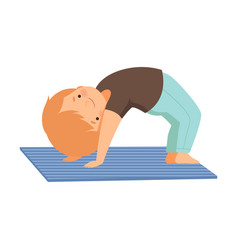
by Neetu | Jun 17, 2020 | Fitness Activity
Posture: Chakra-asana (The Wheel Pose)
Pronunciation: chu-krah-sa-na
Description:
Chakra, from the root cak (“to move”) means wheel and therefore this is the Wheel Posture.
The cakra-asana is also known as the urdhva-dhanurasana.
Urdhva means raised, elevated or upright and dhanur means bow. Both “wheel posture” and “raised bow posture” describe the appearance of this asana.
Performing Instructions
- Lie flat on the back in the shava-asana (corpse pose).
- While exhaling bend the knees and bring the feet as close to the buttocks as possible with the soles of the feet flat on the floor.
- Bend the arms at the elbows and place the palms of the hands flat on the floor directly under each shoulder with the fingers pointing toward the back.
- While inhaling slowly, begin to raise the head, back, and buttocks off the floor while arching the spine. Continue to press downward on the hands and feet while raising the hips and stomach as high as possible.
- Hold for the duration of the held inhaled breath. When you can’t hold the breath comfortable any longer, slowly exhale and return the back to the floor, slide the legs out straight returning to the shava-asana.
Comments:
The chakra-asana is more challenging than most other yoga postures. Don’t be discouraged if you are unable to accomplish it right away. Even attempting this posture without successful completion holds great benefits.
First and foremost is the strength and suppleness it restores to the spine. It strengthens the arms, shoulders, and upper back as well and stimulates the cardiovascular system. The chakra-asana has an overall tonic effect on the entire body.
As the natural suppleness of the spine is restored after a period of practice you can begin to perfect the form of this asana and thus experience greater benefits.
First, be certain that the arms are as straight as possible with very little to no bend in the elbows. When you can hold this comfortably, begin breathing through the nostrils while holding the posture and attempt to get a greater arch in the spine by bringing your hands closer to your feet and/or bringing your feet closer to your hands. Finally, you can extend the duration of the chakra-asana by doing several repetitions in sequence without resting in-between. As you return from the posture keep the hands behind the shoulders and the soles of the feet flat on the floor and as soon as the back returns to floor immediately raise it and enter the full posture again.
Duration/Repetitions:
The chakra-asana is either held for the duration of the inhaled breath or between one and three minutes while breathing gently through the nostrils. Repeat it two or three times.
The “Bridge” Variation:
Although this variation is much easier to perform than the full chakra-asana, it shares several of its benefits. In particular, it will help to stretch the spine and relieve tightness in the upper back and shoulder area.
To get the full benefit of the bridge variation continual effort should be applied to raising the back upward and creating the greatest possible arch with the spine.
While holding the bridge breath slowly through the nostrils. If there is no discomfort felt in the spine or shoulders then one should advance to the full variation of the chakra-asana as described above. Both variations strengthen the back and promote the flexibility of the spine. Tightness in the back and spine results from poor posture, stress, a sedentary lifestyle, and/or emotional disturbances. You should begin to feel the tightness being released after just a few repetitions.










